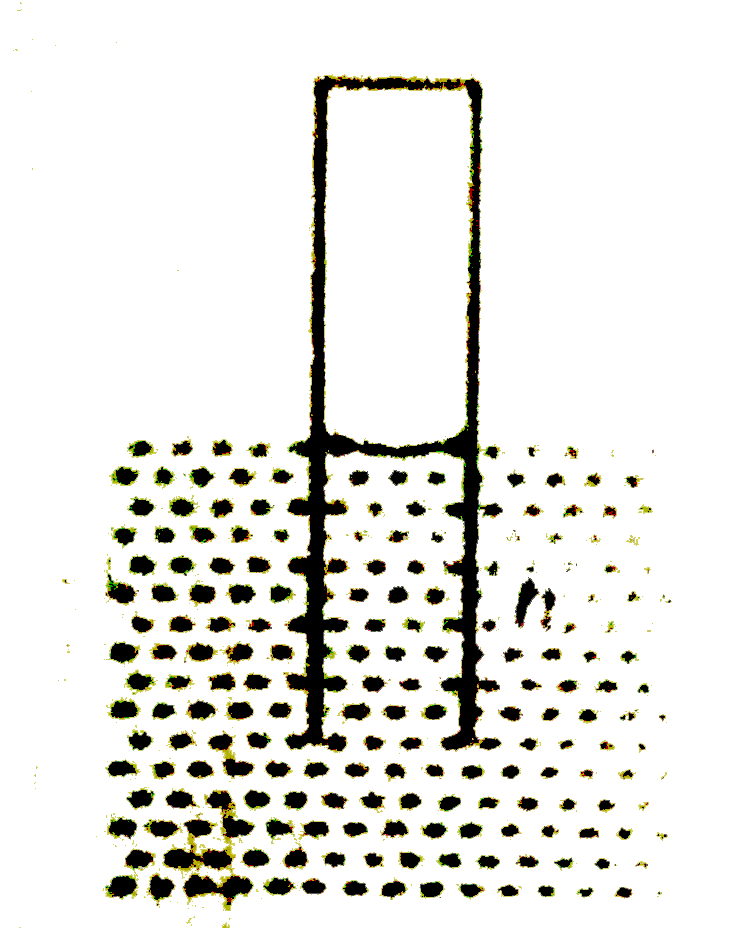A glass capillary sealed at the upper end is of length 0.11mand diameter 2×105m.The tube is immersed vertically into a liquid of surface tension 5.06×10−2N/m. To what length has the capillary to be immeresed so that the liquid levels inside and outside the capillary become the same? What will happen to the water levels inside the capillary if the seal is now broken?
Let P0 be atmospheric and P1 the pressure of air witin the sealed tube. Then for equilibrium pressure just below the menicus should be equal to atmospheric pressure because levels of water inside and outside the tube is same.

i.e., (P1−2Tr)=p0 or P1=P0+2Tr
If L=0.11m is the length of tube and x the length of immersed part then from Boyle's law
p1V1=p2V2
P0La=(P0+2Tr)(L−x)a
where a is the corss sectional area of tube,
i.e., P0×L=(P0+2Tr)(L−x)
P0×L=P0(L−x)+2Tr(L−x)
i.e., P0x=2Tr(L−X)
1.012×105×x+2×5.06×10−21×10−5(0.11−x)
solving for x we get x=0.01m
Length of capillary to be immersed 0.01m
If seal is broken the water level in the capillary rises.
Topper's Solved these Questions
- PROPERTIES OF SOLIDS AND FLUIDSBOOK - CENGAGE PHYSICS ENGLISHCHAPTER - PROPERTIES OF SOLIDS AND FLUIDSEXERCISE - Exercise 5.1
12 Videos
- PROPERTIES OF SOLIDS AND FLUIDSBOOK - CENGAGE PHYSICS ENGLISHCHAPTER - PROPERTIES OF SOLIDS AND FLUIDSEXERCISE - Exercise 5.2
6 Videos
- PROPERTIES OF SOLIDS AND FLUIDSBOOK - CENGAGE PHYSICS ENGLISHCHAPTER - PROPERTIES OF SOLIDS AND FLUIDSEXERCISE - INTEGER_TYPE
2 Videos
- NEWTON'S LAWS OF MOTION 2BOOK - CENGAGE PHYSICS ENGLISHCHAPTER - NEWTON'S LAWS OF MOTION 2EXERCISE - Integer type
1 Videos
- RIGID BODY DYNAMICS 1BOOK - CENGAGE PHYSICS ENGLISHCHAPTER - RIGID BODY DYNAMICS 1EXERCISE - Integer
11 Videos
Similar Questions
A glass capillary sealed at the upper end is of length 0.11m and internal diameter 2×105m. The tube is immersed vertically into a liquid of surface tension 5.06×10−2N/m. To what length the capillary has to be immersed so that the liquid level inside and outside the capillary becomes the same. What will happen to water level inside the capillary if the seal is now broken?
View SolutionA glass capillary of length l and inside radius r(r<<l) is submerged vertically into water. The upper end of the capillary is scaled. The atmospheric pressure is p0. To what length h has the capillary to be submerged to make the water levels inside and outside the capillary coincide. Assume that temperature of air in the capillary remains constant. (given, surface tension of water = T, angle of contact between glass water interface =0∘)

View Solution
Knowledge Check
If the surface tension of water is 0.06 N/m, then the capillary rise in a tube of diameter 1mm is (θ=0∘)
A1.22 cmB2.44 cmC3.12 cmD3.86 cm
A capillary tube of inside diameter 1 mm is dipped vertically in a liquid of surface tension 63×10−3N/m and density 1262kgm3. Find the height of the capillary rise if the angle of contact is 10∘.
View SolutionA capillary tube of length 12 cm and inside diameter 0.033m is dipped vertically into water. The top end of the capillary is sealed. If the outside pressure is 1.01×105N/m2. Find the length to which the capillary tube should be submerged in water so that the levels inside the outside coincide. σ=72×10−3N/m.
View SolutionA spherical drop of water has 1mm radius. If the surface tension of water is 70×10−3N/m, then the difference of pressure between inside and outside of the spherical drop is:
View SolutionRadius of a capillary is 2×10−3m. A liquid of weight 6.28×10−4N may remain in the capillary, then the surface tension of liquid will be:
View SolutionA spherical drop of water has 1 mm radiusHf the surface tension of water is 75×10−3 N/m, then difference of pressure between inside and outside of the drop is
View SolutionWhen a capillary tube is dipped in a liquid, it rises in the tube to a height h above the outside level . What would happen it the tube is dipped such that its length outside the liquid is less then h? Explain your answer briefly.
View SolutionA long capillary tube of radius 0.2mm is placed vertically inside a beaker of water.
If the surface tension of water is 7.2×10−2N/m the angle of contact between glass and water is zero, then determine the height of the water column in the tube.
View Solution
